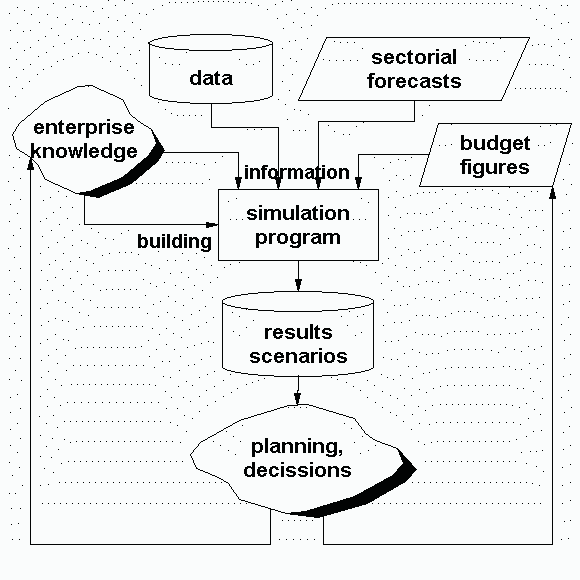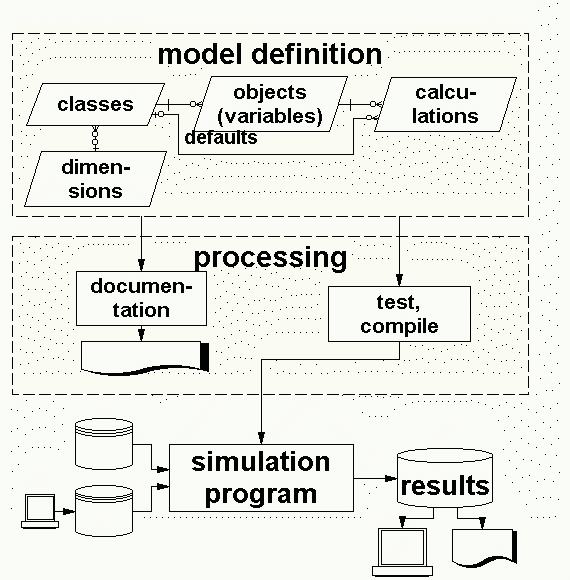An Object Oriented Simulation and Forecasting Tool with the SAS® System
Wilfried Schollenberger
Paper held on SEUGI 1996 in Berlin
Paper held on SEUGI 1996 in Berlin
Contents:
- simulation technology
- business management simulations
- specific demands in the project
- object oriented model
- implementation of object orientation in the application
- SAS® System as application development platform
Let's start with a simple statement:
The speed of reaction on emerging developments becomes more and more important for the success of enterprises.
If you agree with this statement you should also agree to the following:
Looking into the past is not sufficient to set the course for the future.
Simulation and forecasting are means to meet the challenges of today.
Simulation Technology
- well known examples
- world models
(Forester, Global 2000) - planning models
(Ifo, Roland Berger) - company systems
Thomas Witte: Simulationstheorie und ihre Anwendung auf betriebliche Systeme (1973!!)
- world models
- different types
- Monte Carlo simulation
use random number generators and show distributions- production plants
- queues
- System Dynamics
do not use random numbers, results are reproduceable- world models
- housing markets
- Monte Carlo simulation
Simulation for Business Management Needs

Demands
- easy access to different data sources
- integrated reporting system
(management information) - providing data for other information systems
- easy and flexible definition of models
- easy maintainance of models and further development
- automatic documentation
The curent task was
Planning of Liquidity and Profitability
- simulation of the main accountancy
- input from existing forecasts and estimations
- modelling of processes with delays
- 2000 accounts and auxiliary variables
- support for the recognition of errors during the model definition
- step by step approach for the creation of the models
(object orientation) - complete documentation including cross reference lists
- step by step approach for the creation of the models
- easy further development and refinement
Main Structure

Object Orientation?
Due to a number of reasons the object oriented approach has to be modified:- development of a model by evolution
Starting with a simple model it must be possible to further develop it.- classes will be further developed (changed)
- variables may change their class
- this requires methods to balance a new class structure with an earlier developped model under the control of the developper
- class model
- strict control of types
- the class model defines the sequence of calculations
- default calculations
- limited inheritance
- test program to control the consistency of a class model
- documentation
Various documents are created automatically from the class and model definitions. - enhancements
The actual version of OSiPT has an implementation of "dimensions" using the "WS Planungs-Klassen". A dimension is a hierarchical definition of items. A class definition may be linked to such a dimension. Then a model variable is a vector of these items and will be automatically summarized after calculations have been performed according to the definition of the class. In the model definition phase you cann address the variable itself as a vector and the individual items.
Integrated Application
- integration of data access and preparation
- execution of the simulation and management of different scenarios with comments and documentation
- modularisation
deviding a model into submodels and managing the execution - reports for executives
using a report generator - what if analyses using codeless development of panels. Each variable of the model can be placed on the screen as input or display field. Tables and charts are supported as well.
- comparisons of plan and actual
- interactive information system with drill down paths
Implementation using the SAS System
The most important reasons for implemening such a tool using the SAS System were the knowledge of the developper and the fact, that most of the data was already stored in a SAS database.
But there are also other reaons for using the SAS System:
- application development environment
- short development time
- flexible adjustment to new demands
- support for prototyping concepts
- investment securty
- the programs are easy to understand and easy to maintain by the customer
- they are portable to any platform supported by the SAS System
- data access and preparation
- datastep compiler and SCL(to compile the class and model defintions)
- SAS/ETS®(to incorporate elaborated forecasting methods)